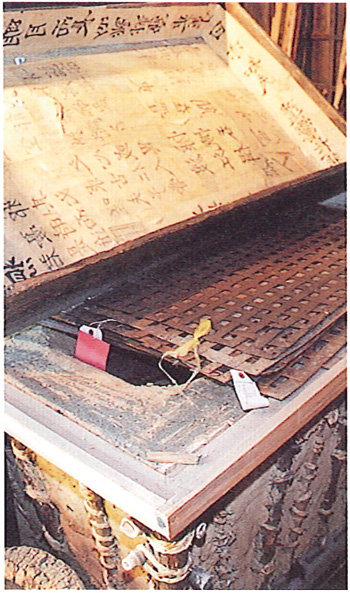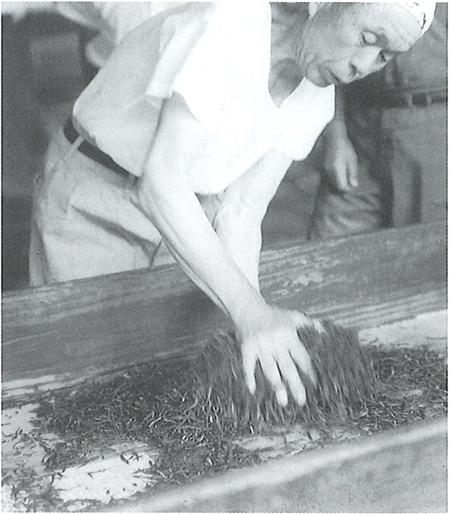 郷土資料館に行って狭山茶について調べてみましょう。 郷土資料館に行って狭山茶について調べてみましょう。 | Let's go to the Museum of Local History and Culture to find out about Sayama tea. |
| 狭山茶について調べるために郷土資料館(きょうどしりょうかん)に行き,話を聞きました。 | We went to the Museum of Local History and Culture to listen to talks in order to find out about Sayama tea. |
 郷土資料館の人の話 郷土資料館の人の話狭山茶が作られる前にも,瑞穂町(みずほまち)のまわりの地いきでは,ちがった作り方でお茶を作っていました。でも,それらのお茶は,今のようにお茶の葉(は)の新しいめをつんで作ったおいしいお茶ではありませんでした。かたくなった葉を使ったかんたんな飲み物(のみもの)だったようです。 | Talking to a person at the Museum of Local History and Culture Even before Sayama tea was grown, tea was grown using different methods here in the area around Mizuho. However, those teas were not the delicious tea that you drink now made from picking fresh new tea leaf buds. It seems as though it was a simple drink made from using hard tea leaves. |
| 江戸時代(えどじだい)の終わりごろ瑞穂町の村野盛政(むらのもりまさ)という人と,入間市(いるまし)(埼玉県(さいたまけん))の吉川温恭(よしかわよしずみ)と指田半右衛門(さしだはんえもん)という人が,力を合わせて狭山茶を作りあげました。 | Around the end of the Edo period, a person named Morimasa Murano from Mizuho, Yoshizumi Yoshikawa and Hanemon Sashida from Iruma (Saitama prefecture) worked together to create Sayama tea. |
| お茶の始まり 日本でお茶の木を育てるようになったのは狭山茶ができたころよりずっと早く,800年ごろだといわれています。勉(べん)強のために中国に行っていたおぼうさんが,お茶の木のたねを持ち帰り,畑にまいたのが,始まりだといわれています。 | The beginnings of tea It is said that tea started to be grown in Japan long before Sayama tea was made, around the year 800. They say that tea growing started when a monk who had gone to China to study brought back tea tree seeds and planted them. |
| 村野盛政(1764~1819) 坊村(ぼうむら)(今の瑞穂町)生まれ。 | Morimasa Murano (1764 - 1819) Born in the town of Bo (present day Mizuho) |
| 吉川温恭(1767~1846) 二本木村(今の入間市)生まれ | Yoshizumi Yoshikawa (1767 - 1846) Born in the town of Nihongi (present day Iruma) |
| 指田半右衛門(生ぼつ年ふめい) 今井村(今の青梅市(おうめし))生まれ | Hanemon Sashida (dates unknown) Born in the town of Imai (present day Ome) |
 狭山茶がどのようにして作られたのか,くわしく調べてみましょう。 狭山茶がどのようにして作られたのか,くわしく調べてみましょう。 | Let's find out more about how Sayama tea was grown. |
| 狭山茶の始まりについて,くわしく知っている地いきの方にも話を聞くことができました。 | We were able to talk to people in the region who knew a lot about the beginnings of Sayama tea. |
 地いきの方の話 地いきの方の話狭山茶作りを始めたのは,いろいろないい伝えがあって正かくなことはわかりません。でも,こんな話を聞いたことがあります。瑞穂町に住む村野盛政は,畑仕事(はたけしごと)をしながら,近くに住んでいるわかい人にけん道のようなわざを教えていました。吉川温恭は,宮大工(みやだいく)をしていました。 | Talking to people in the region There are a lot of theories about how the growing of Sayama tea started so I can't say for certain. However, I heard that Morimasa Murano, who lived in Mizuho, used to teach a martial art similar to kendo to young people who lived nearby. Yoshikawa Yoshizumi was a miyadaiku, a carpenter who specialized in building temples and shrines. |
| 二人とも,村の人に,お茶の葉の新しいめを使って作ったおいしいお茶を,気軽(がる)に飲んでほしいと思っていました。 | Both of them wanted the people of the town to easily drink tea made from fresh new tea leaf buds. |
| お茶の木に,新しいめを見つけると,お茶作りの研究(けんきゅう)にはげみました。 | The started their research on making tea when they found new buds on the tea trees. |
| でも,しっぱいのれんぞくでした。 | But they didn't have any success. |
| はじめは,お茶の葉をゆでてみましたが,水分が多すぎて,かわかすのに時間がかかり,かおりも色もよくありませんでした。次は,せいろでむしてみました。すると,よいかおりがしました。むしかげんによって,味も色もかおりもちかってくることがわかりました。 | In the beginning, they tried boiling the tea leaves but there was too much moisture and it took too much time to dry the leaves, and the aroma and color were not very good. They then tried to steam them in a steamer, which resulted in a good aroma. They found out that taste, color, and aroma changed depending on how you steam the leaves |
| むした葉どうしが,くっつかないようにかきまぜながら,うちわであおいでさましました。 | They stirred the leaves while they were steamed so they didn't stick together and they cooled them down with handheld fans. |
| その後,火でかわかしてみました。なんとも言えないよいかおりがしてきたので,よろこんでいるとうっすらとけむりが立ち上りました。思わず「あっ」とさけびましたが,間に合わず,だいじなお茶の葉(は)をこがしてしまいました。 | They then tried drying them using a fire. It resulted in such a beautiful aroma that it started to burn and smoke as they were rejoicing. They shouted "oh!" in surprise but it was too late, they had burned the precious tea leaves. |
| それでもあきらめることなく,いろいろな地いきをまわって研究(けんきゅう)を進(すす)め,火を使う仕上げでは宇治(うじ)の方で使(つか)われていたほいろという道具(どうぐ)を取(と)り入れました。ほいろを使うことで,火かげんを調節(ちょうせつ)し,かおりのよいお茶を作り上げました。1810年ごろのことでした。そして,この作り方をもとに,今でもたくさんの人たちが,よいお茶作りにはげんでいます。 | However, they didn't give up and continued their research by going to various regions. They started to use a tool known as a hoiro, which was used in making tea in Uji, for the final phase of the tea making process that used fire. By doing this, they adjusted the size of the fire to create a tea with an outstanding aroma. This was around 1810. Even to this day, a lot of people making great tea using this method. |
| 宮大工 神社(じんじゃ)などを中心にたてる大工 | Miyadaiku A carpenter who specialized in building temples and shrines. |
 | せいろ(「せいろう」ともいう) もちごめ,まんじゅうなどをむす道具 | Seiro A tool used to steam glutinous rice and manju rice cakes. |
| せいろ Seiro | ||
 | ほいろ 火にかざしお茶をかわかす道具 | Hoiro A tool used to dry tea by placing over a fire. |
| ほいろ Hoiro |




